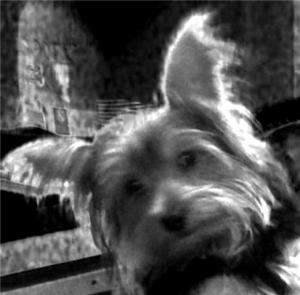Yorkie Puppy Needs 3 Months in ICU
An 8 week old 2 pound Yorkie puppy named Kisses lay on a Spider-man fleece blanket. He did not move. His body temperature was 96 (normal is 101 to 102.5 for dogs.) He had been deathly ill for 3 days.
At 11 pm the night before Kisses’ parents took him out of the ICU; they were out of faith and out of money. They kept him at home for the night, not knowing what to do for him, and brought him to me first thing in the morning.
“We’ll have to let him go. He’s so sick, and we just can’t afford another penny. Please put him down for us.”
They signed the permission form for euthanasia, and went home (they couldn’t bear to stay and watch.) It was up to me to end his suffering. Even my nurses gathered in another room and could not watch.
I leaned over Kisses, a syringe of euthanasia solution at the ready in my right hand. He lay on a blanket, on a heating pad, his IV in his little tiny left arm. As I leaned close to speak in his ear, he lifted his tiny round head and licked my nose. It was the most I had seen him move in hours.
I leaned back on my heels, and just said, loudly, “No way, I just can’t do it!” The nurses came bursting in the room, “Oh, Thank God!”
“Okay, who’s adopting the Yorkie?”
One of my nurses volunteered.
“Get on the phone. Tell Kisses’ parents we’ll take care of his medicine and adopt him out, if they approve of us not euthanizing him.” His parents were crying and grateful. Surprisingly, they never called to ask about him after that day.
Kisses spent 3 months in my hospital receiving treatment for severe parvovirus enteritis, pneumonia, and malnutrition. The parvo virus ruins the lining of the gut, so it’s hard to digest and absorb nutrition. Meanwhile, fighting the pneumonia eats up proteins and nutrients at an alarming rate. It’s a deadly 1-2 punch that is difficult to survive. After three intense months, Kisses was ready to go home with his new mom.
He is now about five years old, and runs the household. Tomorrow, I’ll tell you about how Kisses became a seizure alert dog for Billie, the cat.




Just saw this post, thank God these people found this vet, some vets would not have had a heart and saw the plea this little one made for help. Thank you for caring.
Thanks for reading, Stormie-
It cost about $4,000 to treat the puppy plus all the unpaid nursing care and home care from the wonderful nurse. It is a decision I had to make early on in my career about whether the goal is to help animals or the goal is to stay financially solvent. I choose the animals.
From 1970 to about 2000, most cat and dog veterinarians in the US worked for the animals. They started to try to retire in 2000 and the business people told them they were not profitable and no one would buy their veterinary practices! If you think about it, in the 70’s and 80’s, most of the veterinarians were solo practitioners or had a small staff. The vet and their spouse did the managing, book keeping, often the accounting, the human resources and payroll and OSHA training and compliance, and they were the full time veterinarian caring for the patients also! When they started to look at retirement, the prospective business buyers said, “Hmmm (average vet pay in 1999=$80,000). now I have to pay a vet, a bookkeeper, a receptionist (how many vets had their spouse as the manager and receptionist and bookkeeper? Mine did!), a manager. That’s over 200K (US) right there! This place isn’t making any money!!! Those olde-tyme vets were relying on the money from selling their practice to fund their retirement. They were in a terrible, tight spot and could not retire for many more years. Combine that crisis with the rise of the large corporate practices that hire 10-30 veterinarians and 80 support staff and invest in expensive equipment like MR machines, the pet owners saw their prices and options skyrocket in the early 2000’s. It seemed like many veterinarians suddenly got greedy.
I did not see it that way. I knew the financial situation and I saw that the veterinary industry in the US was suddenly catching up with decades of unsustainable business practices (like they have said on Shark Tank, it’s a nice hobby, but how am I gonna make any money?). The unfortunate effect was stressed-out, hurried, high cost, high medical tech and diagnostics style of medicine became “standard of care” especially in the major cities. It seemed like veterinarians became all about the money. I can tell you from inside the industry, veterinarians are a caring bunch of people. If they come off as unapproachable, or cold about the money, consider that they are selected for vet school by straight A grades and heavy science classes. The people that are selected to get in to vet school are not social butterflies or socially practiced, for the most part. They are likely more uncomfortable than an average person talking about emotions and ethics and financial concerns. And they desperately want to help your pet. And the way they know how to do that is to diagnose, prescribe, and perform surgery. So that is what they offer.
I think information and information curating and sharing are a medical professionals biggest assets that people want to access. And caring. A veterinarian must care for your pet and show they care. (It does no one any good if they can’t show it.) Snuggles was a lucky little Yorkie. He taught me the magic and miracle of what medicine can achieve when the medical team cares and refuses to give up. Amazing things can happen.
In health,
Doc Truli